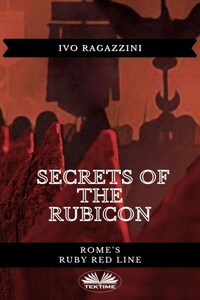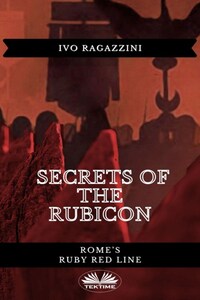Ivo Ragazzini
Under the Green Claws
The last of the Ghibellines
An historical account
Original title:
Sotto le Branche Verdi -- Gli Ultimi Ghibellini
Translated by: Rosemary Dawn Allison
Original title: Sotto le Branche Verdi -- Gli Ultimi Ghibellini
English translation by Rosemary Dawn Allison
Under the Green Claws -- The Last of the Ghibellines
© Ivo Ragazzini
All rights reserved
First edition in Italian 2013 -- MJM Edizioni
Second edition in Italian © Ivo Ragazzini -- 2021
Cover:
Patalakha Sergii/Shutterstock.com
The Ordelaffi Coat of Arms the "Green Claws" degli Ordelaffi
© All rights, including translations of the present work into any language are reserved by the author.
Reproduction and use of this work, even partial and by whatever method graphic, electronic or mechanical, is not permitted without the author's authorization.
The same does not authorize, either the modification, or the translation of one or more parts of said work.
For all requests or information please write to [email protected] or contact the author.
In 1282, after a long series of hostilities between the Guelphs and Ghibellines, an army, organized by Pope Martin IV, composed of eighteen thousand French and Italian Guelph soldiers, was sent to Romagna to defeat once and for all the last of the Ghibellines who had gathered in Forlì to defend the land, which they considered to be their imperial dominion.
The last of the Italian Ghibellines, who were still faithful to the dictates of Emperor Frederick II, who had been dead for thirty years, converged from all sides to help the people of Forli, who still proudly carried the black imperial eagles on a field of gold, which Frederick II himself had personally given them.
The subject of this book is how things turned out and why this situation evolved.
This book is also about what Romagna represented in ancient times. Romagna is a land rich with traditions and history that have been handed down over the centuries.
It is not that difficult to find out how this land was created and what Romagna was at the time of the Rome Empire, and in fact you will see that this story will investigate a few of these themes.
Sooner or later I'll write a detailed historical account of Romagna, but the real purpose of this book is, and remains, the siege and battle, which involved the last of the Italian Ghibellines and took place in Forlì towards the end of the thirteenth century.
So, as this story will inevitably recount, for the first time ever, much of the information about the true origins of Forlì, the monuments and imperial traditions it inherited and why it became the last stronghold of the Ghibellines.
The book will explain who the Ordelaffi really were, and about the many other forgotten historical figures, such as the astrologer Guido Bonatti and the fighting friar Geremia Gotto, who were then also present among the ranks of the Ghibelline.
Of course it will also tell you the details of how the Ghibellines, commanded by Guido da Montefeltro, an unrivalled Italian captain at the time, defeated and massacred, in one day and one night, a French army of eighteen thousand French and Italian Guelphs who had put siege to them to force their submission to the church.
This historical account is thus dedicated to the honor and pride of the last of the Italian Ghibellines who, refusing to surrender to force of arms, and against all the odds, attacked and defeated the thousands of soldiers who had besieged them for a year. I conclude by telling you that this book will inevitably lead you to discover many other things that history has forgotten, and I gladly offer them for your perusal.
Enjoy this rediscovery.
I.R.
Inscription on an old tombstone dated 1282 set into the facade of an ancient funeral monument that was once placed in the center of Piazza Maggiore in Forlì, and had vanished for centuries.>1
PER IL CAPRICCIO DEL ROMANO PONTEFICE MARTINO IIII, GIOVANNI D'APPIA DUCE DELL'ESERCITO FRANCESE IN ITALIA, E I SOLDATI FORLIVESI, SI DIEDERO BATTAGLIA DA ENTRAMBE LE PARTI NEL LUOGO DOVE TI TROVI.
BEN PRESTO DAL POPOLO DIFENSORE FURONO RESPINTI, E TUTTI GLI OTTOMILA COMBATTENTI DISPERSI.
CON ESSI PERSERO LA LORO VITA DUE MILA SOLDATI SCELTI CHE QUI GIACCIONO.
IL DUCE FORLIVESE GUIDO FELTRANO, CALENDIMAGGIO MCCLXXXII (1282).
(On the whim of the Roman pontiff Martin IIII, Giovanni d'Appia duke of the French army in Italy, and the soldiers from Forlì, both parties were in combat in the place you stand.
The defending populace quickly repulsed them, and all eight thousand fighters were killed.
With those who lost their lives were two thousand select soldiers who lie here.
The Forlivese duke Guido Feltrano, May Day MCCLXXXII [1282])2
This plaque was dedicated specifically to the victims of a violent battle that was fought hand to hand, street by street, by the Forlì Ghibellines, inside the walls of their town, against an army made up of French and Italian Guelphs that had been sent by Pope Martin IV.
This plaque and the monument, which at the time proudly indicated the exact place in Piazza Maggiore where the Ghibellines and Guelphs battled for a day and a night and how it ended.













